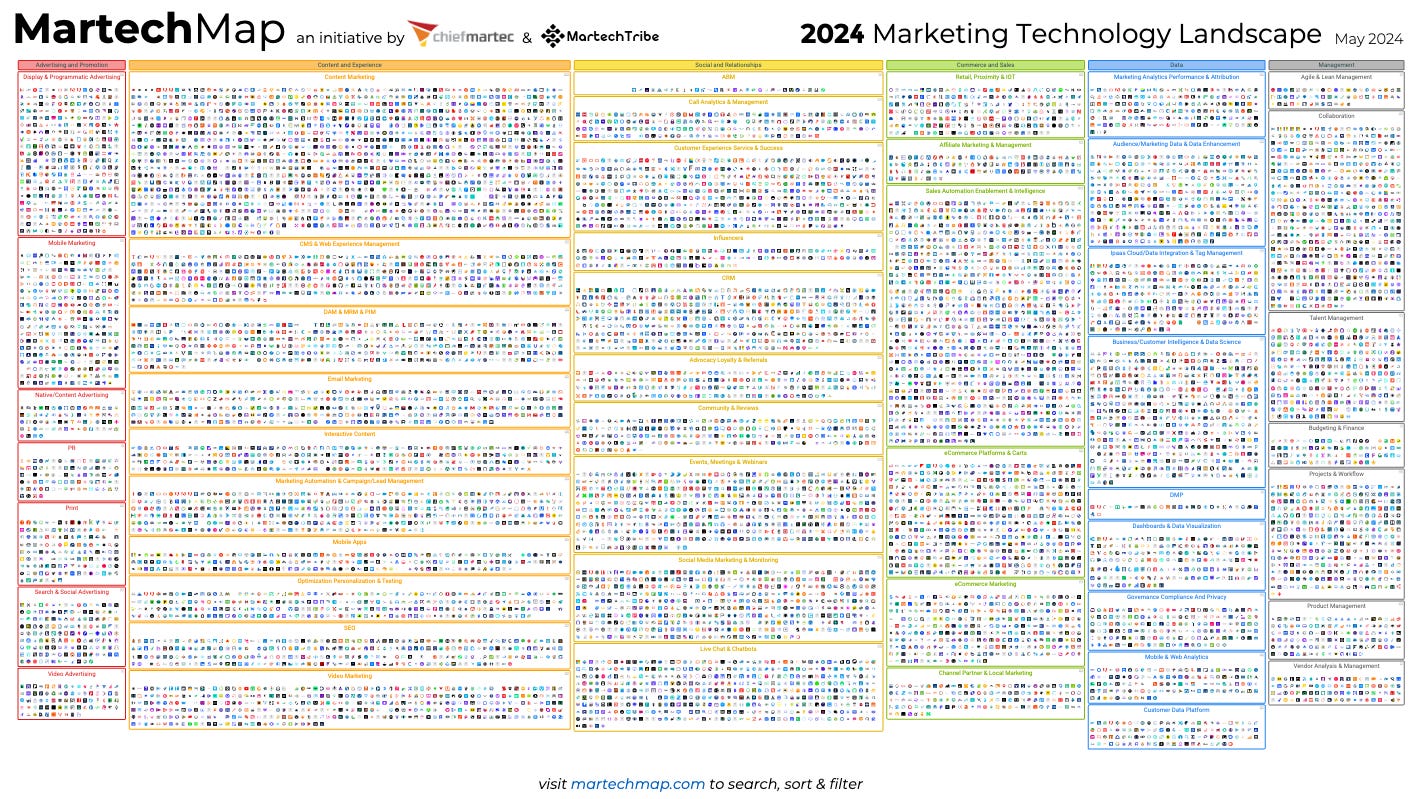The AI-Ready Martech Stack: 3 Steps to Future-Proof Your Marketing Strategy
Credit: MartechMap 2024 Marketing Landscape
In 2025, the marketing landscape will be shaped more than ever by artificial intelligence (AI). For CMOs, the question isn’t just about adopting AI but ensuring their marketing technology (Martech) stack is ready to leverage AI’s full potential. An AI-ready Martech stack isn’t just about having the latest tools—it’s about building a system that integrates seamlessly, scales efficiently, and delivers actionable insights.
But here’s the challenge: while 60% of marketing leaders say they plan to invest in AI tools, only 30% feel confident their current Martech stack can support these innovations. Are you in the 30%, or are you playing catch-up?
Let’s explore how you can future-proof your Martech stack for the AI era with three critical steps—and why acting now is essential to staying competitive.
1. Conduct a Comprehensive Tech Stack Audit
Your Martech stack may already include dozens of tools, but how well are they being utilized? The first step in preparing for AI is to evaluate what you have and identify gaps.
Action Steps:
List all tools: Create an inventory of every tool in your Martech stack, noting its primary function.
Assess utilization rates: Are features being underused? Are certain tools redundant?
Evaluate integration capabilities: Can these tools share data seamlessly with AI platforms?
Why It Matters:
AI thrives on interconnected systems. Without a unified data flow, even the most sophisticated AI tools will underperform.
Real-World Example:
A mid-sized ecommerce company recently audited its Martech stack and discovered that two separate tools—one for email campaigns and another for customer analytics—were performing overlapping functions. By consolidating into a single, AI-enabled platform, they reduced costs and improved data sharing, enabling more effective personalization.
Pro Tip: If your tools don’t communicate effectively, prioritize integration-ready platforms or consider consolidating overlapping functions.
2. Prioritize Data Readiness
AI is only as good as the data it processes. Ensuring your data is clean, centralized, and accessible is crucial for effective AI adoption.
Action Steps:
Eliminate silos: Use tools like a Customer Data Platform (CDP) to centralize customer information.
Focus on data quality: Remove duplicates, fill gaps, and standardize formats.
Future-proof storage: Ensure your data warehouse (e.g., Snowflake, BigQuery) is scalable for increasing volumes.
Why It Matters:
High-quality data enables AI to deliver more accurate predictions, smarter personalization, and better campaign performance. Poor data leads to flawed insights and wasted potential.
Hypothetical Scenario:
Imagine launching a new campaign based on AI-driven customer segmentation. If your data includes duplicate profiles or outdated information, your campaign could target the wrong audience, wasting both time and budget. Now imagine the same campaign with clean, centralized data—you’d see higher ROI and engagement.
Pro Tip: Build a process for continuous data cleansing and validation to maintain readiness over time.
3. Invest in Scalable, AI-Native Platforms
The next generation of Martech tools are AI-native, meaning they’re designed with AI capabilities built-in. Investing in these tools ensures your stack is future-ready and flexible.
Action Steps:
Research AI-native tools: Look for platforms designed for critical functions like personalization, attribution, and automation (e.g., Dynamic Yield, Bizible).
Test scalability: Can the platform handle increased demands as your team scales?
Prioritize user-friendliness: Ensure your team can adopt and maximize these tools without steep learning curves.
Why It Matters:
AI-native platforms don’t just add efficiency—they unlock new capabilities, like real-time optimization and predictive analytics, that legacy tools can’t match.
Case Study:
A SaaS company switched to an AI-native attribution tool and saw immediate results: better insights into multi-touch campaigns, real-time adjustments, and a 15% increase in conversion rates within three months.
Pro Tip: Don’t just adopt AI tools for the sake of it. Ensure every addition aligns with your broader business objectives.
Checklist: Is Your Martech Stack AI-Ready?
Have you audited your tools for redundancy and underutilization?
Is your data centralized, clean, and accessible?
Are you investing in platforms that integrate seamlessly and scale effectively?
Do your tools align with your business objectives and AI strategy?
Final Thoughts: Beyond the Tools
An AI-ready Martech stack is more than a collection of tools—it’s a strategy. CMOs who embrace this shift will not only enhance their team’s efficiency but also deliver measurable results that drive revenue and customer satisfaction.
The time to act is now. Start with an audit, focus on your data, and choose AI-native platforms that align with your goals. The future of marketing will belong to those who are prepared to work smarter, not just harder.
What’s the first step you’ll take to audit your Martech stack? Let’s start the conversation in the comments below!


